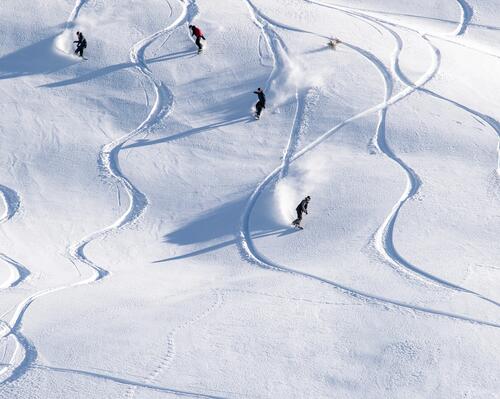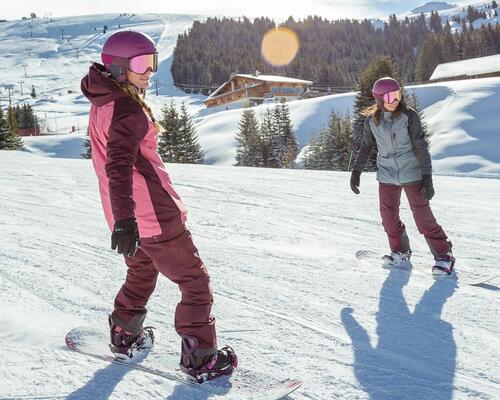

Snowboarding glossary
Time to go shredding, ride in switch... and try to understand what we are talking about with our snowboarding glossary.
a
Aerial/air
Straight jump with a kicker. That's how it all starts.
All mountain
Name given for a daring board that enables you to ride freestyle and freemountain; it is a versatile snowboard.
We can also use this word to refer to a versatile style of riding.
Alpine
Long and narrow board designed for speed and wide curves, especially for carving. It is used with rigid boots and special bindings (plates).
Arva/avd
Appareil de recherche de victimes d’avalanche (A.R.V.A.)/Avalanche Victim Detector (A.V.D.). Enables a person buried under an avalanche to be located if they have an ARVA/AVD in "transmit" mode. At the same time, it enables to find people that has been stuck under the avalanche if the ARVA is in "search" mode.
b
Backcountry
This word describes the off-piste riding technique used to go in powder snow (fresh snow).
Backside
It is the back edge of the board, where your heels are.
Also used to describe tricks where action is on the heel edge. Examples: backside 180, backside lipslide, backside air...
Base
The part of the board in contact with the snow.
Bind
Short for binding.
Board
One of the names used to call the snowboard, tool used to slide downhill with unparalleled grace. Also works with "snowboard".
c
Canting
Adjusting canting enables lateral or frontal (front/back) angle on the binding. Customising your canting comes from Alpine snowboarding, you can find soft bindings with customized canting on the binding's footbed.
Carving
For aesthete who love beautiful curves, carving enables you to draw them on the slopes by turning on the edges, without skidding or sliding. It is a clean, clear curve that results from cutting the snow with your edges.
Curve radius
The radius of the circle left by the board edges during a carved turn.
d
Deck
A board.
Disk
The disks are the parts that enable the bindings to be attached to the snowboard with 4 screws.
Double backside rodeo 1080
Side twisting rotation, one of the most beautiful creations in snowboarding.
Downhill
Downhill, down the mountain. On the slopes, the people downhill have priority.
Drop
Jumping or dropping from something. We can drop when you do a freestyle jump, when you enter a half-pipe or when you go down off-piste.
e
Edge
Metallic part that goes around the board and is in direct contact with the snow when at an angle. When you carve a turn almost lying down on the snow, just for fun, it all rests on the edge. Regularly sharpening the edges enables you to turn better on the ice.
f
Fakie
Riding backwards. If you are regular, you snowboard goofy, and vice versa. Learning it will enable you to get out of perilous situations.
Flat
Making tricks in contact with the snow on a gentle slope by turning the board.
Flex
A snowboard's flex is its ability to deform the board. Soft flex is more tolerant and manoeuvrable and is recommended for freestylers and beginners. A stiffer board will be great for more precision and speed and it is recommended for carving and more experienced riders.
Freecarve
A type of board or alpine snowboarding.
Freeride
It is a snowboarding technique which consists in riding all types of terrain in backcountry, normally down virgin slopes in snow as soft as cotton candy, that's freeride snowboarding.
Freestyle
A riding practice those who love jumps and tricks. Usually practiced in a Snow Park. If you grab your board to throw a Double Backside Rodeo 1080 after breakfast, you are a freestyler.
Frontside (turn)
Turn on the tip of the toes, facing the snow, the mountain, the slope, facing the unbelievable beauty of the terrain, frontside, basically.
g
Gas pedal
The front part of the binding base-plate, which can be adjusted so that your toes press down on the binding and have good precision.
Goofy
Position with the right foot at the front of the board.
Grab
Trick in which you grab your board during a jump. The main grabs are: nose, tail, indy, mute, sad, stailfish.
h
Half-pipe
Snow half-pipe, one of the areas where freestylers can express themselves with jumps and tricks. An half-pipe is a huge snowy structure that has the shape of half a tube, snowboarders ride inside the pipe up towards the walls and upwards.
Handplant
A trick in which you balance on one hand and lift up your board. There are many different variations.
Hard boots
Rigid alpine snowboarding boots.
High-back
Also known as the spoiler, it is the back part of a binding that enables backside turns by pressing on the heels and ankles.
i
Indy (grab)
Grabbing the board between the two feet with the back hand.
Inserts
They are the holes on the top of the snowboard on which the bindings are fixed.
k
Kicker (or kick)
The top part of a jump where you leave the ground, the jump begins and the fall awaits. Oooh, don't be negative.
n
Nose
The front end of the board. The nose, as it were.
Nose grab
Trick where you grab the nose of the board. All right?
Nose press
A trick in which you slide while balancing on the nose (front end) of the board.
Noseslide
A trick that you can do on modules, you slide the board at 90° while pressing on the nose. The trick can be done as a back boardslide or front boardslide.
o
Ollie
Inspired by skateboarding, this trick consists in giving an impulsion to jump with the board, using the flex of the board and the side movement of the body. There are three different types of ollie: ollie, switch ollie, nollie.
p
Pipe
Quarter of Half-Pipe. The least useful definition in this glossary.
Powder / pow pow
Fresh, light snow. The cause of euphoria in freeriders.
Pretzel
Adding a 270° dismount in the opposite direction after a 90° slide.
Pumping
Increasing speed by pushing down in descents and cushioning in ascents.
r
Rail
It is a metal bar on which you can slide with your snowboard and do different manoeuvres. There are different types of rails that are often named after their shape (down rail, flat rail, rainbow rail)
Regular
Position with the left foot on the front of the board. It is the usual position for right-handers, but isn't always the case.
Revert
180° rotation on the ground.
Ride
Practicing a board sport. I ride, you ride, we ride.
s
Sad
Trick in which you grab the board with your front hand between the heels.
Shape
The shape of the board if you look at it from the top as you are fixing you bindings. Shapes are different depending on the discipline.
- Twin Tip
- True Twin Tip
- Directional Twin Tip
- Directional
- Alpine
Shell
Flexible binding that is used with softboots. With a base-plate, two large straps and a high-back. A nice piece of gear.
Shifty
It is a 90° rotation during a jump, where you return to your original position on landing. It consists on a twisting motions of the core of the body.
Slide/ sliding
It is the movement you make when you glide on the snow or on a module.
Slopestyle
It is a type of snowboarding competition in which you must complete a full run in a snowpark with a sequence of jumps and modules. It is important to manage concentration during the course, as the flow will be judged.
Stance
Gap between the feet. It is measured from the middle of one binding to another.
Strap
Parts of bindings that ensure to block the foot and prevent movement of boots inside bindings.
There are two straps on a binding: the toe strap and ankle strap.
Swallow
Board designed to ride in powder snow. It is the same shape as the very first snowboards. The tail is cut like a swallow's tail, fish tail.
Switch
Ride in the opposite direction. Goofy for a regular and vice versa.
t
Tail
Back part of the snowboard.
Tail press
It is a slide on the tail of the board (the back tip of the snowboard).
Tailslide
A slide on modules with the board at 90° on the tail.
Tip
The front and back of your snowboard, it is the raised part.
Tracked
Fresh snow with tracks in it
Trick
Term inspired by skateboarding, describes a aeria or jibbing manoeuvre. For information, you "Do a trick".
u
Uphill
Uphill, up the mountain.
v
Vitelli turn
Named after Serge Vitelli, its inventor, this type of turn is carried our with the armpit to the snow. Yes, you have read that correctly. Thrilling speed guaranteed.
w
Waist
The narrowest part at the middle of the board.
Waxing
Applying special paraffin to the sole to protect it and improve slide.
Wind slab
Compact layer of unstable snow formed by the wind. Often the cause of slab avalanches, they are an important danger off-piste.
#
1440°
Jump with four complete rotations. We can name the Backside Triple Cork 1440 for example, a very fun way to spice up your Sundays.
180°
A jump spinning the board with a half rotation. The landing will be with the opposite front foot from the one you started the jump with.
360°
Jump spinning a full rotation. The front foot at landing will be the same one at starting.
540°
A jump spinning one and a half rotation.
Share your snowboarding experiences and add to this glossary in the comments!


